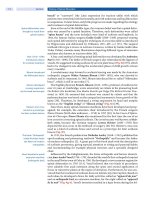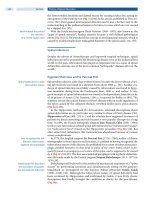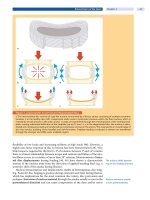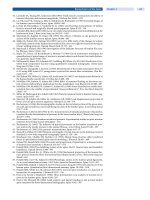Spinal Disorders: Fundamentals of Diagnosis and Treatment Part 1 pot
Bạn đang xem bản rút gọn của tài liệu. Xem và tải ngay bản đầy đủ của tài liệu tại đây (176.75 KB, 10 trang )
Norbert Boos · Max Aebi (Editors)
Spinal Disorders
Fundamentals of Diagnosis and Treatment
Norbert Boos · Max Aebi (Editors)
Spinal Disorders
F undamentals of Diagnosis and Tr eatment
With 274 Figures in 1290 Parts
and 190 Tables
Prof. Dr. Norbert Boos
Zentrum für Wirbelsäulen- und Rückenmarkchirurgie
Universität Zürich
Universitätsklinik Balgrist
Forchstraße 340, 8008 Zürich
Switzerland
Prof. Dr. Max Aebi
Institut für Evaluative Forschung in Orthopädischer Chirurgie
MEM Forschungszentrum, Universität Bern
Stauffacherstraße 78, 3014 Bern
Switzerland
ISBN 978-3-540-40511-5 Springer-Verlag Berlin Heidelberg New York
Library of Congress Control Number: 2006927571
2008 Springer-Verlag Berlin Heidelberg
This work is subject to copyright. All rights are reserved, whether the whole or part of the
material is concerned, specifically the rights of translation, reprinting, reuse of illustrations,
recitation, broadcasting, reproduction on microfilm or in any other way, and storage in data
banks. Duplication of this publication or parts thereof is permitted only under the provisions
of the German Copyright Law of September 9, 1965, in its current version, and permission for
use must always be obtained from Springer-Verlag. Violations are liable to prosecution under
the German Copyright Law.
Printed in Germany
The use of general descriptive names, registered names, trademarks, etc. in this publication
does not imply, even in the absence of a specific statement, that such names are exempt from
therelevantprotectivelawsandregulationsandthereforefreeforgeneraluse.
Product liability: The publishers cannot guarantee the accuracy of any information about
dosage and application contained in this book. In every individual case the user must check
such information by consulting the relevant literature.
Cover design: eStudio Calamar, Spain
Illustrations: Alain Blank, Zürich, Switzerland
Printed on acid-free paper
987654321
springer.com
Dedication
To Christa, Anna, Lisa and Sarah N.B.
To Christine, Eva and Samuel M.A.
For their love, understanding, encouragement and tolerance,
without which this book would not have been possible
Foreword
Form Follows Function
Congratulations to the editors and authors on a truly outstanding book. Most
books recapitulate what many already know, and leave one seeking more. This
book is unique in its content and format. “Form follows function”, popularized
by the great American architect Frank Lloyd Wright, is a principle associated
with modern architecture and industrial design in the 20th century. Simply
stated, the shape of a building or object should be predicated by or based upon its
intended function or purpose. Like this phrase there is often a history that is
important to recognize and understand if we are to truly understand its meaning.
The origin of the phrase “Form follows function” can be traced back to the
American sculptor Horatio Greenough, but it was American architectural giant
Louis Sullivan who adopted it and made it famous. Sullivan actually said, “form
ever follows function”, but the simpler (and less emphatic) phrase is the one usu-
ally remembered. Sullivan’s student and assistant Frank Lloyd Wright adopted
this principle in slightly different form – perhaps because shaking off the old
styles gave them more freedom and latitude.
Drs. Boos and Aebi have adopted a particular form, in this book, in order to
give the reader a thorough grounding in the basic knowledge and general princi-
ples of spinal disorders. The didactic concept (form) of all the chapters is based
on a consistent style and layout, and follows three basic principles of sustainable
learning (functions), i.e.: (1) less is more, (2) repetition enhances sustained
learning, and (3) case studies are an efficient and complementary means of learn-
ing.
The book utilizes learning aids to highlight and repeat core messages through-
out all chapters, and visual aids facilitate a repetition-based learning approach,
starting with the core messages, leading to an in-depth reading of each chapter.
Marginal notes allow for effective repetition of material to facilitate the learning
process, and outstanding graphics with pictorial and anecdotal learning meth-
ods are used to complement the many detailed case studies to exemplify the core
messages. Finally, the use of important references and landmark articles makes
this a prized book for everyone’s shelf.
Congratulations to Norbert and Max on a fantastic contribution. This book
will help those most in need, our patients. “Form and function” are the most
important outcomes of this work, especially for those of us who work everyday to
care for people with these various spinal disorders. Thank you.
James N. Weinstein
Director, The Dartmouth Institute for Health Policy and Clinical Practice
Professor & Chairman, The Department of Orthopaedics
Editor-in-Chief – Spine
Dartmouth College and Medical School
Dartmouth Hitchcock Medical Center
Lebanon, New Hampshire, USA
VII
Foreword
Dinosaur or State of the Art?
Long ago, medical observations, advances, innovations and reviews were first
presented at meetings and published in books. With the introduction of scientific
medical journals, two things happened. First publication time was cut down dra-
maticallycomparedtobooksanddisseminationofknowledgebecamefaster.
Secondly a new approach to scientific publication was introduced in the form of
peer review. This again lengthened publication time, yet benefited quality. Some
argued that scientific journals would herald the slow death of books. History
proved them wrong.
The advent of the internet again mixed up all the cards. Would scientific jour-
nals survive the internet? Initially the peer review aspect was lost and the quality
of available knowledge suffered. Yet, sites like Wikipedia introduced the very
concept of peer review online. So, would the internet kill peer review journals let
alone books? Well, here again history demonstrates that both journals and books
remain alive and well.
This book on spinal disorders edited by Norbert Boos and Max Aebi is a typi-
cal example of the kind of textbook anybody involved with matters regarding the
spine wants on her or his desk. Moreover, this work is unique because it is not a
classic multi-author textbook. The editors have approached chapter authors with
whom they personally collaborated and share a common philosophy on the diag-
nosis and treatment approach to spinal disorders. By an intensive editing pro-
cess, the different chapters have been woven into a homogeneous book combin-
ing personal experience with evidence based knowledge.
Editors of scientific journals know that so-called “review articles” are very
popular, more referenced than other articles and thus excellent for boosting a
journal’s Impact Factor. Well, this book consists of a succession of reviews bring-
ing us a real “state of the art” regarding the spine but put into perspective through
personal experience. This work is truly pluri-disciplinary and reflects the com-
plex and difficult nature of the human spine. Among the authors we find clini-
ciansaswellasscientists.
The editors tackle every aspect of the spine in a well balanced way. No topic is
superfluous or perceived as more important than another and the book reads as
one continuous flow, one topic logically leading to the next. This book can be rec-
ommended to anyone involved in clinical or research aspects of the spine. It sim-
ply has to lie on the desk of doctors, scientists, physiotherapists and chiroprac-
tors, psychologists and health-care specialists interested in the spine.
Robert Gunzburg
President 2007–2008
EuroSpine, the Spine Society of Europe
Cavell Spine Center
Brussels, Belgium
IX
Preface
Spinal disorders are among the most common medical conditions, having a sig-
nificant impact on health-related quality of life, use of health care resources and
socioeconomic costs. As a therapeutic measure, spinal surgery is still one of the
most rapidly growing areas in clinical medicine, and is a major contributor to the
continuously increasing costs of modern-day medicine. Similarly, the increas-
ingly aging population will have a greater need for the treatment of degenerative
spinal disorders, particularly secondary spinal deformities and stenosis. How-
ever, at the same time limited health care resources will mean difficult choices in
the allocation of treatment modalities. Therefore, a basic knowledge of the state
of the art of the diagnosis and treatment of spinal disorders is required, not only
for spine specialists but also for general orthopedic surgeons, rheumatologists,
neurologists, rehabilitation doctors, psychiatrists, chiropractors, physiothera-
pists, basic scientists and health care executives, to enable them to choose and/or
evaluate appropriate diagnostic and therapeutic approaches.
Owing to the rapid development of knowledge of spinal disorders over the
past 20 years, a comprehensive new textbook which incorporates all the latest
knowledge has become necessary, and we have become aware again and again of
innumerable residents, fellows and colleagues searching for a comprehensive
introductory learning tool for the study of spinal disorders. Although excellent
textbooks on specific issues of the spine and specifically spinal surgery are
already available, none fulfills the criterion of being an easily readable teaching
tool that focuses systematically on the fundamentals and basic principles in a
standardized manner. Strongly encouraged by our residents and fellows, we have
designed a textbook on spinal disorders which is an integration of the evidence-
based knowledge in the up-to-date literature and our decade-long personal expe-
rience at the source of research and treatment of spinal disorders.
With Springer, we found a dedicated publisher willing to give our book project
strong support, and with carefully selected chapter authors we have hopefully
succeeded in creating a consistent message throughout the book. Unlike many
other spinal textbooks, the editors did not want simply to collect and edit chap-
ters from many different authors, which often leads to an inhomogeneous book
with overlapping, redundant and incoherent chapters. We rather aimed to pro-
vide a homogeneous syllabus with a consistent didactic strategy to teach the fun-
damentals and general principles.
Althoughwehavebasedtheinformationinthisbookonanextensivesurvey
of the peer-reviewed literature, we have moderated this information in a synthe-
sis with research and clinical experience. We have, however, refrained specifically
from an in-depth description of sophisticated surgical procedures. For this field
of expertise, there are already a number of excellent manuals and textbooks
available.
Althoughwerecognizethedifficultyandchallengeofourtask,wefeelthatwe
have fulfilled our goal by choosing authors with whom we have collaborated for
a long time and who concur with our own philosophy. The didactic concept is
XI
presented in every single chapter in a consistent manner and is based on three
principles:
1. Less is more when concisely written
2. Repetition enhances sustained learning
3. Case studies are an invaluable means of exemplifying important principles
We hope that we have met our objective in providing a modern, up-to-date and
easy to read textbook on spinal disorders with an appealing layout, and that the
book will inspire and stimulate the reader in the study of spinal disorders. It is
our hope that this book may become the standard basic textbook for spinal disor-
ders if you, the reader, decides to make this happen.
We would like to thank all the contributing authors for their major commit-
ment and hard work. We would also like to thank our students, fellows and col-
leagues for critically proof-reading the chapters and their constructive and
encouraging feedback. We owe many thanks to Doris Stettler and Grit Gagel-
mann for their support and help with the editing process. We further thank Wil-
liam Shufflebotham in the UK for copy-editing the book. We also want to
acknowledge the Medical Pictorial Documentation team of the University Hospi-
tal Balgrist (Heidi Wylenmann, Helene Uhlmann and Christian Streng) for their
invaluable help with the editorial preparation of the medical images and figures.
We are particularly indebted to Alain Blank, who created the unique illustra-
tions with his meticulous and careful attention to the anatomical and surgical
details. The major book sections are separated by the paintings of Arnaldo Ricci-
ardi, who perfectly understood how to transform his inspirations of spinal disor-
ders into works of art. We also thank Springer, the publisher, and specifically
Gabriele Schröder for making this book happen.
Zürich and Bern, March 2008
Norbert Boos Max Aebi
Centre for Spinal Surgery MEM Research Centre for
University Hospital Balgrist Orthopaedic Surgery
University of Zürich University of Bern
XII Preface
Contents
1 History of Spinal Disorders
Philipp Gruber, Thomas Boeni
CoreMessages 1
ABriefEtymology 1
HistoricalCaseIntroduction 2
SpinalAnatomyandPhysiology 4
AnesthesiaandSupportiveTechniques 6
LaughingGas,ChloroformandCocaine 6
AntisepsisandAntibiotics 6
DiagnosticImaging 8
Scoliosis 8
Pathogenesis 9
Assessment 9
Non-operativeTreatment 11
ScoliosisSurgery 13
JuvenileKyphosis 13
Spondylolisthesis 14
AnObstetricalProblem 14
Surgery 14
BackPainandSciatica 15
AWrongMixtureofFluids 15
DiscHerniation 17
HistoricalCaseStudy 19
TheFacetSyndrome 21
SpinalStenosis 21
SpinalInfections 22
EgyptianMummiesandSirPercivalPott 22
Treatment 24
AnkylosingSpondylitis 24
DiscoveryofaNewDisease 25
SpinalInjuries 27
FirstReports 27
Spinal Injuries as a Socioeconomic Problem
28
TractionTableandLaminectomy 29
TheAdventofInternalSpinalFixation 29
Recapitulation 30
Appendix:Historyofspinaldisorders 31
KeyArticles 33
References 34
Basic Science
2 Biomechanics of the Spine
Stephen Ferguson
CoreMessages 41
TheHumanSpine 41
TheMotionSegment 42
AnteriorStructures 42
PosteriorElements 46
LigamentsoftheSpine 47
MotionSegmentStiffness 48
Muscles 48
Spinal Stability Through Muscular Activity . . 52
Muscle Activity During Flexion and Extension 54
Muscle Activity During Lateral Flexion and
Rotation 54
SpineKinematics 54
RangeofMotion 55
Mechanical Response of the Spinal Motion
Segment 55
Clinical Instability . . . 57
Kinetics(SpinalLoading) 58
StaticLoading 58
LoadsDuringLifting 59
DynamicLoading 60
Recapitulation 61
KeyArticles 62
References 63
3 Spinal Instrumentation
Daniel Haschtmann, Stephen J. Ferguson
CoreMessages 67
GoalsofSpinalInstrumentation 67
Basic Biomechanics of Spinal Instrumentation
69
Loading and Load Sharing Characteristics . . . 69
PosteriorStabilizationPrinciples 71
AnteriorStabilizationPrinciples 74
AnteriorTensionBandTechnique 78
Biomechanicsofthe“AdjacentSegment” 79
Non-FusionPrinciples 80
DiscArthroplasty 80
Nucleoplasty 82
Posterior Dynamic Stabilization Technique . . 82
XIII









